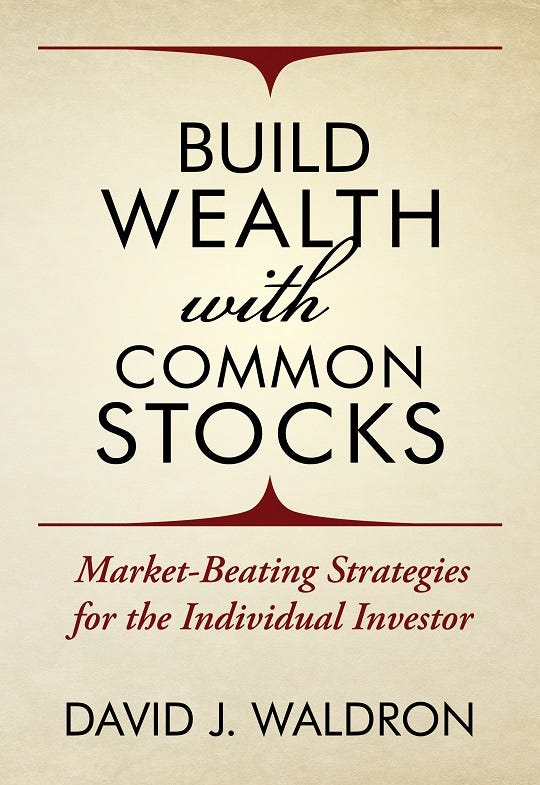Introduction | Build Wealth with Common Stocks
Revised and updated | Build Wealth with Common Stocks: Market-Beating Strategies for the Individual Investor
Audio voiceover:
Substack’s AI-generated voiceover is now available on By David J. Waldron. To access, open the chapter in the Substack app. Please share your thoughts in the comments or via direct message. I plan to use AI to clone my voice for the book’s official audiobook release.
Learn more about audio voiceovers:
https://davidjwaldronbooks.substack.com/p/audio
Haven’t read the previous chapters? You can find them here on my webpage:
https://davidjwaldronbooks.substack.com/p/build-wealth-with-common-stocks
INTRODUCTION
Build Wealth with Common Stocks is a book dedicated to individual private investors, featuring a well-structured and implemented model portfolio of total return common stocks as a real-time case study highlighting the benefits of buy-and-hold, value-driven, retail-level investing.
The book is designed for everyday investors who want to build or maintain a portfolio that supports significant milestones, such as buying a home, funding a college education, sponsoring a wedding, pursuing a passion, starting a business, or enjoying a comfortable retirement.
Build Wealth with Common Stocks supports private retail investors committed to enhancing their investment knowledge. They maintain discipline in conducting due diligence to identify quality publicly traded companies represented by common stocks that demonstrate wide margins of safety. Furthermore, they exhibit patience in allowing capital gains and dividends to accumulate and compound personal wealth over time.
If this opening resonates with you, consider reading the book and joining an investment community dedicated to uncovering value and building wealth without supporting the Wall Street fee machine.
Readers Best Served
Regardless of their specific niche, individual private investors are encouraged to read this book because pursuing excellence in long-term, buy-and-hold stock investing has a broad scope. While the book invites all investors to participate and benefit, it is best suited for the following pre-retirement retail investor profiles.
Investors seeking to open or maintain existing personal brokerage or tax-deferred accounts, such as a 401(k), 403(b), individual retirement account (IRA), Roth IRA, or 529 tuition plan, or equivalent, and who want to establish or build upon a self-managed, buy-and-hold investing approach to personal money management.
Investors employing professional money management services—such as investment advisors, discount brokers, and financial planners—or who rely on a family member to manage their brokerage or tax-deferred investment portfolios, who aim to deepen their understanding of the active portfolio management process, enhance effective communication, and ensure proper oversight of the money manager.
Investors who enjoy discovering new ideas to address everyday personal finance challenges will find value in this approach. Since money is often considered taboo, Build Wealth with Common Stocks is designed as a straightforward and safety-oriented resource for exploring the thoughts, ideas, and obstacles of do-it-yourself investing. Some investors may disagree with or completely dismiss some of the principles, strategies, and practices presented in this book, choosing what they find helpful while leaving the rest behind.
Investors committed to—or have a keen interest in—the value investing model, which involves buying predominantly dividend-paying common shares of excellent businesses when trading at reasonable prices. The late Columbia Business School professors Benjamin Graham and David Dodd developed the model, which gained popularity through renowned investors such as Warren Buffett, William Browne, Joel Greenblatt, Seth Klarman, Peter Lynch, Howard Marks, Charlie Munger, John W. Rogers Jr., Charles Royce, Geraldine Weiss, and Martin Whitman, among other legends.
What to Expect from Build Wealth with Common Stocks
This book aims to provide value to readers by focusing on screening, researching, and selecting potential ownership stakes in publicly traded companies that offer lasting legacies to stakeholders, including customers, employees, vendors, suppliers, regulators, the broader community, and current or future shareholders.
Out of respect for readers, Build Wealth with Common Stocks rejects any short-term trading schemes that promise quick financial gains, even if such gains appear hopeful, albeit improbable, particularly when using controversial investment vehicles. Therefore, the book discourages options, futures, event arbitrage, currencies—whether crypto or sovereign—commodities, trend following, short-selling, technical analysis, swing trading, momentum growth, forward high-yield dividends, price targets and alerts, trading algorithms, margin accounts, deep value, or any other trading schemes designed to acquire fast money. The author concedes that these speculative ventures are better suited for professional traders, market gamblers, and those who consult the Ouija board.
Investment advice tailored to each reader’s unique financial situation is intentionally absent. The text must maintain an impersonal narrative in accordance with securities laws and regulations. The book presents broad concepts drawn from the author’s personal experience. Consider the author as an educator and well-intentioned facilitator, rather than a stock market guru, for the benefit of do-it-yourself investors.
As of the time of this Introduction's writing, the author’s real-time concentrated family portfolio has significantly outperformed its benchmark since August 2010, based on the average total return of each representative holding. This market-beating performance continued during the COVID-19 pandemic in 2020, the inflationary bear market of 2022, and the trade war correction in 2025, making the stock market as volatile and unpredictable as during the financial crisis and the Great Recession of 2008–2009.
Principles, Strategies, and Practices
Self-directed common stock investing is straightforward, though not effortless. It is attainable, yet daunting. Comprehensive, focused research conducted with thought, discipline, and patience has a higher chance of outperforming the market over a long holding period.
Whimsical references to “the market” throughout the book symbolize a collective of impulsive retail and capricious professional investors, overwhelmed by the crowd and driven by emotions or greed in their daily buying and selling of investment securities.
Build Wealth with Common Stocks outlines various principles, strategies, and practices for profitable investing that can create market-beating portfolios when consistently applied by long-term-minded individual investors. Over more than twenty years of active investing, the author identified several essential standards—shared in Part I: Principles—that, when combined with a few fundamental measures of a company, often indicate the performance potential of the underlying stock.
In Part II: Strategies, the author examines various aspects of a company and its common shares. His simplified research methodologies uncover the value proposition, quantify shareholder returns, assess management effectiveness, evaluate the stock's intrinsic value, and consider overall downside risks. Companies lacking several targeted traits are eliminated from further consideration.
Part III: Practices integrates the principles and strategies from Parts I and II to help readers build a potentially market-beating, well-allocated, low-cost common stock portfolio.
This book will instruct readers on implementing a bottom-up research approach that involves and considers stakeholders within the company, including the board of directors and senior management. Furthermore, we will regard the market as a stakeholder, even if it serves only as a contradictory confirmation of our investment thesis.
Focusing research on exceptional companies with ethical management that achieve consistent organic revenue growth, sustained profitability, and high returns on equity and invested capital can lead to market-beating portfolios for discerning retail-level investors on Main Street. Become the investor who purchases and holds the common shares of outstanding businesses that provide quality products and services to customers while generating long-term total returns through capital appreciation and income for shareholders.
Are you prepared to apply market-beating principles and strategies, like those detailed in Build Wealth with Common Stocks, to your workplace retirement account, tuition savings plan, or taxable brokerage account?
Do you possess the ingredients for success as a private stock investor across all market cycles?
Continue reading, as you likely have the inherent ability to succeed or are already applying many of the principles and strategies, with opportunities to enhance your success as an individual private investor. A central aim of this book is to promote self-awareness and address any gaps as needed.
The Model Portfolio
The model portfolio presented throughout the book is equal-weighted, meaning each holding represents the same proportional investment based on the dates of the initial common stock purchase or the original publication of the underlying research. This strategic allocation differs from most benchmark indices and professional portfolios. Remember that past performance is not a reliable indicator of future returns.
The model portfolio serves as a concise example that assesses the financial and business metrics of a select group of common shares from publicly traded companies, which comprised an actively managed core family portfolio at the time of writing this edition of the book.
Portfolio updates summarize several key financial indicators at the end of a quarter or fiscal year. The model provides a comparative analysis of the overall performance of representative companies using the business and stock price metrics outlined in Part II: Strategies.
Disclosures
As of this 2025 update, the author’s concentrated family portfolio—featured in the book’s model portfolio and narratives—held beneficial long positions in the common shares of the following companies mentioned in this revised edition (exchange: ticker symbol): Alphabet, Inc. (NASDAQ: GOOGL), Apple, Inc. (NASDAQ: AAPL), Berkshire Hathaway, Inc. (NYSE: BRK.B), The Coca-Cola Company (NYSE: KO), The Kroger Co. (NYSE: KR), McKesson Corporation (NYSE: MCK), Microsoft Corporation (NASDAQ: MSFT), The TJX Companies, Inc. (NYSE: TJX), and Union Pacific Corporation (NYSE: UNP).
In addition to owning shares of common stock and utilizing certain products or services, the author and his immediate family have no other business relationships with the publicly traded companies mentioned. The author can add or remove positions from his family portfolio without public disclosure. To keep track of his investing activities, consider subscribing to the premium content of David’s newsletter, Quality Value Investing, at davidjwaldron.substack.com.
Additional Disclosures
This book provides source material for the general information of interested readers. The accuracy of the data cannot be guaranteed. Narratives and analyses are impersonal and neither tailored to individual needs nor intended for portfolio construction beyond the author’s model portfolio, which is presented solely for illustrative purposes. The author is a private investor and not an investment advisor. It is the reader's responsibility to conduct independent research. Consider consulting, if appropriate, a fee-only certified financial planner, a licensed discount broker, a flat-fee registered investment advisor, a certified public accountant, or a specialized attorney before making any investment, income tax, or estate planning decisions.
Disclaimers
The model portfolio provides a diversified yet focused overview of author-owned or covered collective company components for comparative research. It is neither a marketable security nor intended as investment advice or for portfolio construction. The model portfolio's current and past illustrative performances do not guarantee the actual or future performance of its constituent companies, sectors, and industries, or of the stock market as a whole.
The model portfolio is owned, maintained, and published for the primary financial benefit of the author’s immediate family. It also serves as an educational platform for the active members of his newsletter. Copying, marketing, benchmarking, or disseminating his model portfolio without the author's express written permission is prohibited.
Before reading the entire book, readers must understand and accept the disclosures and disclaimers in this Introduction. They assume responsibility for investment failures or unmet expectations from applying the book's principles and strategies. Each reader is solely accountable for their personal financial decisions.
Financial Services Sector
Although the book adopts a skeptical view of Wall Street—a term commonly used to describe professional or institutional investing worldwide—it does not suggest or convey any particular issues or negative implications concerning actual organizations or individuals in the financial services sector.
Any perceived reference to actual companies or real individuals is coincidental and unintentional. In its general lament of Wall Street’s fee-driven culture, the book avoids unproven conspiracy theories and offers a narrative nonfiction platform for commentary, critique, education, and parody.
In the world at large, facts exist independently of alternative viewpoints. Thus, the author's subjective thoughts throughout the book reflect his opinions and are therefore separate from fact.
Trademarks
Companies often register trademarks to identify and distinguish their products from those of others. The brand and product names in this book are the owners' trade names, service marks, or registered trademarks. The author and publisher have no association with any external products or vendors mentioned in this book. Except for those featured with permission on the cover or in approved marketing messages, none of the individuals or organizations referenced in the text have endorsed the book.
Gender Neutrality
The principles, strategies, and practices presented in the book apply equally to all genders. The author uses gender-neutral pronouns throughout the text for clarity and consistency.
Links to the Author’s Website and Model Portfolio
Although limited in frequency, the links to the author's website in the book remain accessible to the public at no cost.
The reader understands that the author assumes no responsibility or liability for any damages resulting from electronic viruses that may occur when accessing any websites listed or implied in the book, particularly when researching investment-related material. The author does not take responsibility for the persistence or accuracy of URLs for external or third-party internet websites mentioned or implied in this book, and does not guarantee that any content on such sites is or will remain accurate or appropriate.
Access to the model portfolio and other exclusive member resources enhances the experience for readers who subscribe to the author’s newsletter at davidjwaldron.substack.com or visit the author’s website at davidjwaldronbooks.substack.com. The author earns a living from various passive income sources, including investment-related capital gains, dividends, book royalties, newsletter subscriptions, and affiliate marketing. If you find value in this read, please consider leaving a review on your purchase site, recommending the book to a colleague, friend, or family member, or buying a copy from your favorite online bookstore as a gift for someone special.
For the Reader's Benefit
In Part III: Chapter Sixteen, under the “Stock Screen User Guide and Definitions” section, you will find an annotated glossary of various investing terms presented in the book. Readers should bookmark this section in advance and refer to it as needed.
In deference to the proliferation of book abstracts in publishing, each chapter concludes with a bulleted summary. Readers are encouraged to use these lists for review, clarification, and quick reference in the future.
Welcome to Build Wealth with Common Stocks
The investment principles, strategies, and practices outlined in the book were derived from the author’s more than twenty years of learning and applying techniques to grow and preserve wealth through self-directed investing.
Build Wealth with Common Stocks is a heartfelt and passionate effort to share personal experiences with readers across all levels of the investing spectrum. It guides them toward mutual investment success by harnessing the magic of compounding, secured by a comfortable margin of safety.
If you enjoy this read, please consider posting a review on the platform where you purchased the book. For any general inquiries or to give constructive feedback, feel free to contact the author at davidjwaldronbooks@substack.com.
INTRODUCTION SUMMARY
On Taking Stock and Responsibility
Build Wealth with Common Stocks is tailored for private investors looking to create or sustain a portfolio that facilitates their life’s essential milestones.
Interested investors are encouraged to read this book as pursuing excellence in long-term, buy-and-hold common stock investing is broad in scope, enabling investors of all levels to engage and potentially thrive.
Build Wealth with Common Stocks rejects short-sighted trading schemes for those seeking hopeful, albeit improbable, quick financial gains.
This book is limited to information and illustrations. The accuracy of the data cannot be guaranteed. The narrative and analysis are impersonal — neither tailored to individual needs nor intended for portfolio construction beyond the model portfolio presented within the confines of teaching and learning. The author is a private individual investor, not an investment advisor. Before making decisions about investments, income taxes, or estate planning, the reader must conduct independent research and consult a licensed professional.
Part III: Chapter Sixteen outlines various investment terms for the reader's benefit. Each chapter concludes with a bulleted summary for review and reference.
This Introduction is copyrighted 2021 and 2025 by David J. Waldron. All rights are reserved worldwide.
Next in Build Wealth with Common Stocks | Chapter One: Get Rich Slow
Universal links allow you to preview or purchase David’s published print or ebooks—each available globally at your preferred online bookstores—with one or two clicks, brought to you by our trusted partner, BookFunnel.





